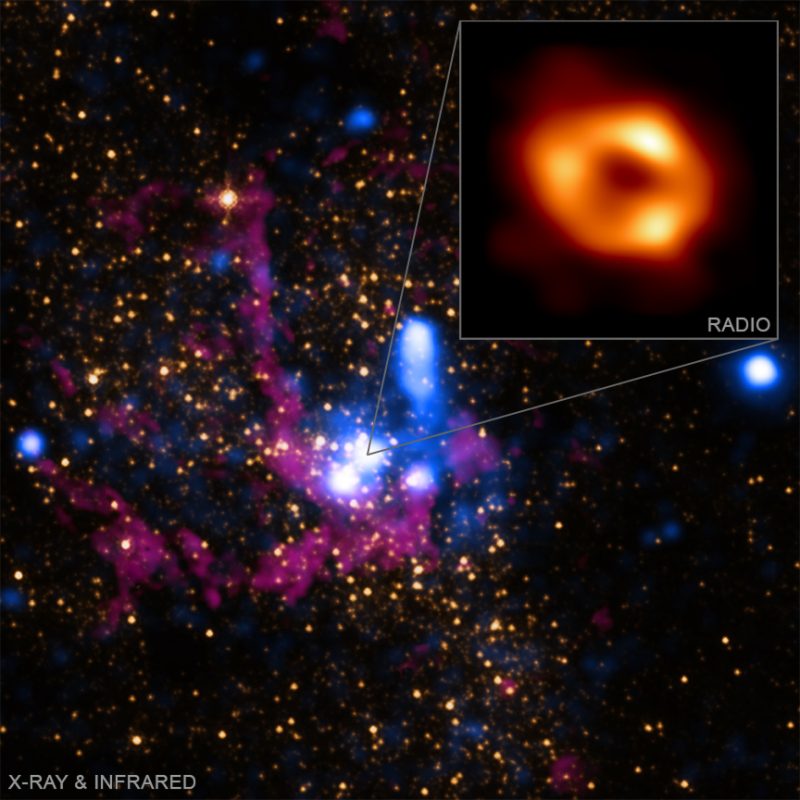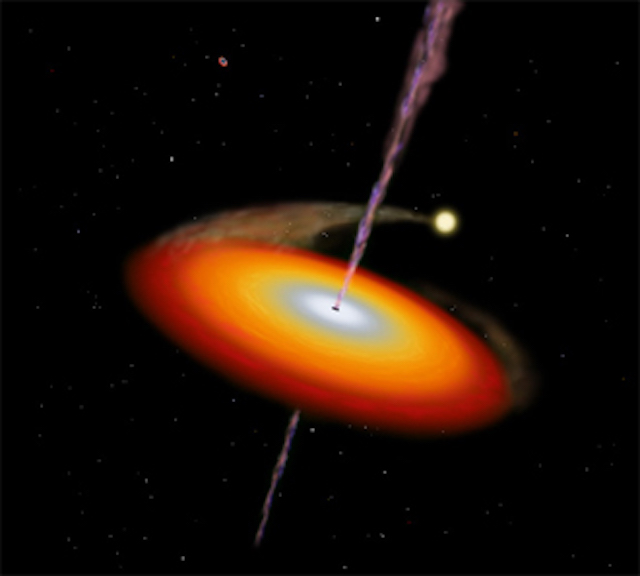
The Event Horizon Telescope – the same group that, in 2019, obtained the first-ever image of a supermassive black hole, in the galaxy M87 – says it will make a groundbreaking announcement on Thursday, May 12, 2022. The press conference will be held at ESO’s headquarters in Garching, Germany, beginning at 15 CEST (13 UTC, or 8 a.m. CDT). The press conference is focused on Sagittarius A*, the supermassive black hole at the center of our own Milky Way galaxy. Could it be the first-ever image of our galaxy’s supermassive black hole? The full press conference will be streamed on ESO’s YouTube channel. While you’re waiting, here’s some background on supermassive black holes!
A supermassive black hole for most galaxies
Modern astronomers believe that most galaxies, including our own Milky Way, have supermassive black holes at their hearts.
They are called supermassive because they contain millions or billions of times the mass of our sun.
So their mass greatly exceeds that of so-called stellar-mass black holes (a few times our sun’s mass to perhaps 150 times our star’s mass). Beyond that, there is a population of so-called intermediate-mass black holes – aka Goldilocks black holes – whose existence has only been confirmed recently, and whose upper mass limit has yet to be determined.
The lightest supermassive black hole so far discovered – in the dwarf galaxy RGG 118, some 340 million light-years distant – has a mass just 50,000 times that of our sun.
At the other end of the scale there is a true monster: the black hole at the center of the quasar TON 618. It possesses 66 billion solar masses, the most massive yet discovered.
Between those two extremes, the mass of a supermassive black hole is typically millions of times that of our sun. The one at the center of our own Milky Way galaxy, for example, possesses 4.6 million solar masses.

How do we know?
But as black holes are black, how do we know they are there at all? What betrays their presence at the center of a galaxy? After all, black holes do not emit any visible light: from a distance they are invisible. Although black holes themselves do not emit visible light, and are thus invisible in optical telescopes, they can emit copious quantities of light outside the visible spectrum – most commonly radio, X-ray and gamma radiation.
This electromagnetic radiation does not originate from the black hole itself, but from the material surrounding it. Many supermassive black holes at the centers of galaxies are embedded in swirling whirlpools of gas and dust known as accretion disks. As particles in these disks, accelerated by the black hole’s gravity to whiz around it at a significant percentage of the speed of light, repeatedly collide with each other they heat up, eventually reaching temperatures of millions of degrees. They consequently generate huge amounts of X-rays.
Astronomers using X-ray telescopes, such as NASA’s orbiting Chandra observatory, can see these emissions across huge distances.
But not all supermassive black holes are surrounded by accretion disks. Some are what is referred to as quiescent: they might or might not have possessed accretion disks in the past. Why are they quiet? It’s because all the gas and dust within reach of their gravity has been swallowed. There is therefore no radiation to betray their presence. Some may periodically emit brief flares as a stray gas or dust cloud veers too close, is heated up and emits X-rays before being consumed by the black hole. Black holes have even been observed to flare brightly as they consume entire stars!
The supermassive black hole in the Milky Way
Our own local supermassive black hole at the center of our Milky Way galaxy – called Sagittarius A*, and often abbreviated to just Sag A* – is a quiescent supermassive black hole some 26,000 light years away. It flares irregularly across a range of wavebands, from radio to gamma but most prominently in the near-infrared. The mechanism responsible for generating these flares is not yet understood. It may represent the black hole’s consumption of dust and gas, or something else entirely we know nothing about.
Because the center of our galaxy is so relatively close, in contrast to distant galaxies, astronomers can observe the stars there. In particular, they can see how stars are moving and at what velocities. At the center of the Milky Way, around a hundred stars orbit Sag A*, held in its gravitational thrall. Since 1995 astronomers have painstakingly plotted the movements of a dozen or stars that are closest to the black hole and animated their paths from the data. It is clear that they orbit some invisible object. From their trajectories and velocities, astronomers can calculate the mass of the object they orbit and have arrived at a figure of 4.6 million times the mass of our sun.
So we know that at the heart of our galaxy there is a supermassive, unseen object that is accelerating nearby stars to incredible speeds. The star which orbits the closest to Sag A*, designated S2, accelerates to 11 million miles per hour at its closest approach! Its orbit takes it to within 120 times the Earth-sun distance of the black hole; its year, or the time it takes to make one orbit of Sagittarius A*, is 15 Earth-years.
These studies of our galactic center have demonstrated beyond reasonable doubt that the Milky Way has its own monster in the dark at its center. All observations of the stars orbiting Sag A* have confirmed the predictions of Einstein’s theory of relativity as it relates to objects orbiting black holes. In 2020, Andrea Ghez and Reinhard Genzel were awarded the Nobel Prize in Physics for their discovery of Sag A* and their painstaking mapping of the galactic center over decades.
As the mass of supermassive black holes varies widely, so do their sizes. Sag A* is thought to have a diameter of about 14 million miles. TON 618, at 66-billion solar masses, has been calculated to be 262 billion miles across! That’s more than forty-three times the diameter of our entire solar system!

Where do they come from?
But where do supermassive black holes come from, and how can they have accumulated such incomprehensible amounts of mass? This is where things get a little complicated. The bottom line is that the evolution of supermassive black holes is still hotly debated. We don’t even know if they all form in the same way, or if there is a variety of mechanisms at play.
What we do know is this: supermassive black holes existed in the very early universe, less than a billion years after the Big Bang. How they became so massive so quickly is still a mystery. It’s possible these early monsters accreted through black holes of lesser mass merging together, eventually forming a supermassive black hole. Another idea is that they formed from the spontaneous collapse of huge clouds of hydrogen. Compress anything in the universe to a certain size and density and it will form a black hole: for example, if you were to compress the Earth to the size of a marble, that’s what would happen. But the fact is we don’t know which model, if any, is correct.
Scientists hope that the James Webb Space Telescope, due to start its science observations this summer, will help to answer the question of how such massive monsters could exist so early in the Universe: the telescope should be able to look back in time to “just” 200 million years after the Big Bang, to see the first galaxies forming.
Which came first?
There’s also the question of why most galaxies have a supermassive black holes at their centers. What’s the relationship between a galaxy and its black hole? In recent years, this question has been the subject of much study. So did a galaxy form first, its supermassive black hole forming afterwards, or did the supermassive black hole form first and then the galaxy accrete around it? This chicken-and-egg question is not by any means resolved. In addition, there is a curious linear relationship between the mass of a supermassive black hole and that of the galactic bulge surrounding it: the more massive the black hole, the more mass there is in the bulge. This points to some sort of co-evolution between the two, but what that relationship is and what it represents we do not yet know.
We do know that supermassive black holes can play a crucial role in star production within a galaxy, something which has only been appreciated in recent years. Relativistic jets being shot out of a supermassive black hole punch their way through a galaxy, either dispersing star-forming clouds of hydrogen so they do not form stars, or compressing them so that they commence star formation. This points to a close relationship between a supermassive black hole and the evolution of its host galaxy, but we are only just beginning to understand the nature of that relationship and what it means for star formation.
Galaxies without supermassive black holes
But what of galaxies that do not have a supermassive black hole at their center? They are few by comparison, but we think we know why the black hole is absent. It involves there being two galaxies which pass very close to each other. Gravitational interactions between their respective supermassive black holes can result in one of the black holes being literally kicked out of its host galaxy! In 2012, a supermassive black hole was observed to be travelling out of its host galaxy at more than 3 million miles per hour! Moreover, its x-ray emissions trailed behind it like a wake, pointing back toward the center of the galaxy. This was the first confirmation of why some galaxies lack supermassive black holes; other examples have been discovered since.
So we can now say with some degree of confidence that all galaxies are born with supermassive black holes, even if some may lose them later. But it’s still chickens and eggs as to which formed first, the galaxy or the black hole.
Supermassive black holes are the true monsters of the universe, whose origins are mysterious and whose relationships with their host galaxies are still poorly understood. It is highly probable, however, that with a whole new generation of super-powerful Earth- and space-based telescopes seeing first light within the next decade, we might be able to unravel their mysteries at last.
The first black hole image
By the way, although bursts of X-rays in far-off galaxies are indicators of the presence of a supermassive black hole, in a court of law this would be viewed as circumstantial evidence only. After all, astronomers had never seen a black hole, even though they were pretty sure black holes exist (because it’d be tough to explain the observations in any other way).
All that changed in 2019, when the Event Horizon Telescope, a global array of radio telescopes, was able, in an incredible technological feat, to image the supermassive black hole at the heart of the galaxy M87. Presented to the world in March 2019, the image, which was front-page news all around the world, was our first actual sight of a black hole. It confirmed many of Einstein’s predictions and is destined to be one of the most iconic science images of all time. It showed the glowing disk of material around the shadow of the black hole, which is a dark area absent of photons because any venturing that close to the supermassive black hole are immediately consumed.
And now that same Event Horizon Telescope is about to make an announcement about Sagittarius A*! Stay tuned!

Bottom line: A large galaxy typically has a supermassive black hole at its heart. These black holes contains millions – to billions – of times our sun’s mass.
The post Supermassive black hole a feature of most galaxies first appeared on EarthSky.
0 Commentaires